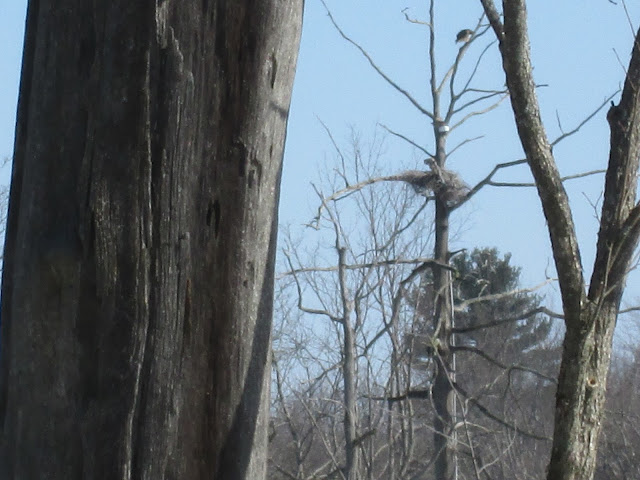I had some free time last Thursday, so I went to the Cornell Lab of Ornithology (which I briefly introduced to you some time ago) to take some pictures of birds and walk around.
Of course, I realized about two minutes after I had left the house that I had forgotten my boots. The trails were sure to be snow-covered, but I figured that by now they had melted down enough so that my sneakers would be ok.
It was a busy day at the Lab. I parked in the outer lot, which, as you can see in the photo, was nearly 1/3 full (the other 2/3 was behind me). The two other lots were nearly full. I'm sure some of those cars were for employees, but there seemed to be quite a few guests in the visitor center and on the trails as well.
I posted a couple of photos of the area near the visitor center before, but much of the area is swampy. Lots of standing water for birds (and mosquitoes!) to drink.
The Lab has over two miles of trails across its swampy grounds...in places, there are elevated wooden walks to guide visitors over the marshy areas that are too soggy to walk on.
Of course, a sign of the swampy/marshy-ness of the area is the cattail.
Here's a look at the visitor center. This relatively new building opened in June, 2002. Inside, it has, among other things, an auditorium, a library of bird materials, an observation area, an information desk, items for sale, and plenty of research space for the Lab's scientists.
Here's the walkway to the entrance. As with anything associated with a major university, many items and spaces - like many of the walkways and benches on the Lab's grounds - were paid for by the generosity of donors.
Here's the view from the observation area out towards the pond. There's a little stone beach that the birds can wander onto. For the observers, there are a couple of high-powered telescopes to look farther out onto the pond.
And here's one thing that you can see: a large great blue heron's nest (I believe). The Lab has cameras trained on this nest and streaming to the Web in the spring so that birders around the world can watch the young hatch and learn to fly. (There's also a camera on Cornell's main campus, right by my building, trained on a red-tailed hawk nest.)
In the pond, near the observation area, a couple of aerators keep the surface thawed for our feathered friends to get a bath and maybe do some fishing?
On the pond this past Thursday right around noon were a bunch of mallard ducks. It seemed to be lunchtime for them, too.
At first, I only saw a couple of ducks, but soon many more floated into view.
The ducks didn't seem to mind the cold too much. The air temperature was a little above freezing, and the water temperature was probably about the same.
On land or in the water, the ducks were looking for some lunch.
For the ducks that climbed onto land, there was usually a lookout...just in case we pesky humans in the building were up to something. Also of note...it was Valentine's Day, and the ducks almost seemed to know this. They were frequently floating, swimming, or waddling in pairs.
I wonder if rocks are a good place for the ducks to find food?
This male looks to be floating reassuringly behind his mate.
And these two are looking for food (or something else?) together. I wonder if they're looking for little insects or bugs in among the rocks?
The male here is keeping an eye out to protect his mate. I guess these ducks, if they live here year-round, are pretty accustomed to being around people.
The ducks would occasionally flap their wings in the water, making a big splash, but it was hard to be quick enough on the trigger.
I did manage to get a couple of decent shots, though.
Look! It's a big foray onto the beach! But eventually, my camera was running low on battery, so I decided to take a hike.
This is the state of the trails...mostly packed-down snow with a little ice mixed in. On some of the elevated walkways, there was more ice than snow. I slipped a couple of times, but for the most part I was ok in sneakers and didn't mind that I had forgotten my boots.
Here's the great blue heron's nest (I zoomed in a lot!) from the other side of the pond. You can see the camera above the nest pretty clearly in this shot. It looks like a hawk is hanging out near the top of the tree.
Here's the visitor center from the other side of the pond. It's a fairly large pond! The observation area is at the right hand side of the picture, and the research space is to the left.
Here's a zoomed-out view to give you a more realistic sense of the scale of things. Can you make out the great blue heron's nest near the center of the picture? I'm planning to go back to the Lab of O again before too long...but hopefully when it's just a bit warmer.



























No comments:
Post a Comment